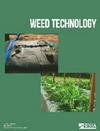利用低隧道描述除草剂、佐剂和靶表面对麦草畏挥发性的影响
IF 1.7
3区 农林科学
Q3 AGRONOMY
引用次数: 0
摘要
摘要2018 - 2022年对低隧道法和空气采样法与麦草畏脱靶运动的相关性进行了研究,主要集中在挥发性方面。本研究分为三个实验,评估了麦草畏中添加的除草剂和助剂以及处理的表面类型对麦草畏挥发性的影响。处理组合包括草甘膦和草铵膦,模拟硫酸铵(AMS)污染率的存在,挥发性降低剂(VRA)的好处,以及草木(抗麦草畏棉花)或土壤表面处理麦草畏。挥发性评估包括在48小时内收集的空气样本。在两个裸露的土壤或棉花托盘中,每个托盘使用四次麦草畏处理,并放置在隧道内。对空气样品中麦草畏的提取和定量进行了研究。田间评价包括生物指示剂大豆的最大和平均可见伤害以及麦草畏损害的横向移动,以从地块中心到植物遭受5%伤害的位置的最远距离表示。在麦草畏中加入草甘膦和草甘膦增加了空气样本中麦草畏的含量。与不含AMS的处理相比,模拟水罐污染率(0.005% v/v)对麦草畏的排放没有影响。与不添加佐剂的处理相比,添加VRA可使空气样品中的麦草畏减少70%。施用于植被的麦草畏通常比施用于裸露土壤的麦草畏产生更多的检测量。田间评估结果通常遵循不同处理麦草畏浓度的差异。结果表明,低隧道方法可以同时比较几种处理组合对麦草畏挥发性的影响。本文章由计算机程序翻译,如有差异,请以英文原文为准。
Use of Low Tunnels to Describe Effects of Herbicide, Adjuvant, and Target Surface on Dicamba Volatility
Abstract Investigations of the relevance of low tunnel methodology and air sampling concerning the off-target movement of dicamba were conducted from 2018 to 2022, focused primarily on volatility. This research, divided into three experiments, evaluated the impact of herbicides and adjuvants added to dicamba and the type of surface treated on dicamba volatility. Treatment combinations included glyphosate and glufosinate, the presence of a simulated contamination rate of ammonium sulfate (AMS), the benefit of a volatility reduction agent (VRA), and a vegetated (dicamba-resistant cotton) or soil surface treated with dicamba. Volatility assessments included air sampling collected over 48 h. Dicamba treatments were applied four times to each of two bare soil or cotton trays and placed inside the tunnels. The extraction and quantification of dicamba from air samples were conducted. Field assessments included the maximum and average visible injury in bioindicator soybean and the lateral movement of dicamba damage expressed by the furthest distance from the center of the plots to the position in which plants had 5% injury. Adding glufosinate and glyphosate to dicamba increased the dicamba amount in air samples. A simulated tank contamination rate of AMS (0.005% v/v) did not impact dicamba emissions compared to a treatment lacking AMS. Adding a VRA reduced dicamba in air samples by 70% compared to treatment without the adjuvant. Dicamba treatments applied on vegetation generally produced greater amounts of dicamba detected than treatments applied to bare soil. Field assessment results usually followed differences in dicamba concentration by treatments tested. Results showed that low tunnel methodology allowed simultaneous comparisons of several treatment combinations concerning dicamba volatility.
求助全文
通过发布文献求助,成功后即可免费获取论文全文。
去求助
来源期刊

Weed Technology
农林科学-农艺学
CiteScore
2.90
自引率
21.40%
发文量
89
审稿时长
12-24 weeks
期刊介绍:
Weed Technology publishes original research and scholarship in the form of peer-reviewed articles focused on understanding how weeds are managed.
The journal focuses on:
- Applied aspects concerning the management of weeds in agricultural systems
- Herbicides used to manage undesired vegetation, weed biology and control
- Weed/crop management systems
- Reports of new weed problems
-New technologies for weed management and special articles emphasizing technology transfer to improve weed control
-Articles dealing with plant growth regulators and management of undesired plant growth may also be accepted, provided there is clear relevance to weed science technology, e.g., turfgrass or woody plant management along rights-of-way, vegetation management in forest, aquatic, or other non-crop situations.
-Surveys, education, and extension topics related to weeds will also be considered
 求助内容:
求助内容: 应助结果提醒方式:
应助结果提醒方式:


